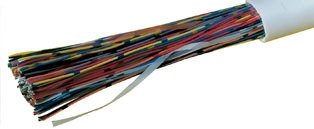
The term telephone cable is used to describe a range of internal, external and internal/external cables that are manufactured for the interconnection of telephone equipment. In some cases, telephone cables may also be utilised for additional applications. Twisted pair cabling is commonly found in telephony, with the twists providing some interference resistance. The pairs of wires within the cable are coded by colour. Twisted pair cable that meets British Telecom specifications is designated as CW1308, CW1308B and CW1128 cable. The external sheath on the telephone cabling may be described as PVC, low smoke and fume (LSF), or low smoke zero halogen (LSOH).
CW1308 Standard for Telephone Cabling
Cables made to the CW1308 standard are multipair phone cables manufactured for internal connections. Cables that comply with CW1308 specifications are often constructed with 0.5mm, copper conductors that are insulated. The number of wire pairings within the cables will vary. A cable might come with 2 pairings or 200. Since 1308B can be used externally, it can feature a UV-resistant outer sheath. The CW1308B cable has common construction features with 1308 but is graded for both internal and external cabling. The technical specifications for each CW1308 and 1308B cable will include a minimum bending radius.
CW1128 Telephone Cable
External grade CW1128 telephone cable is constructed for outdoor use. Cables built to this specification can be installed above or below ground. The armoured CW1128 cable versions are suited for underground installation. CW1128 external grade cables come with various levels of durability. Comms Express can provide information on telephone cable applications, as well as on flat modular telephone cable.
